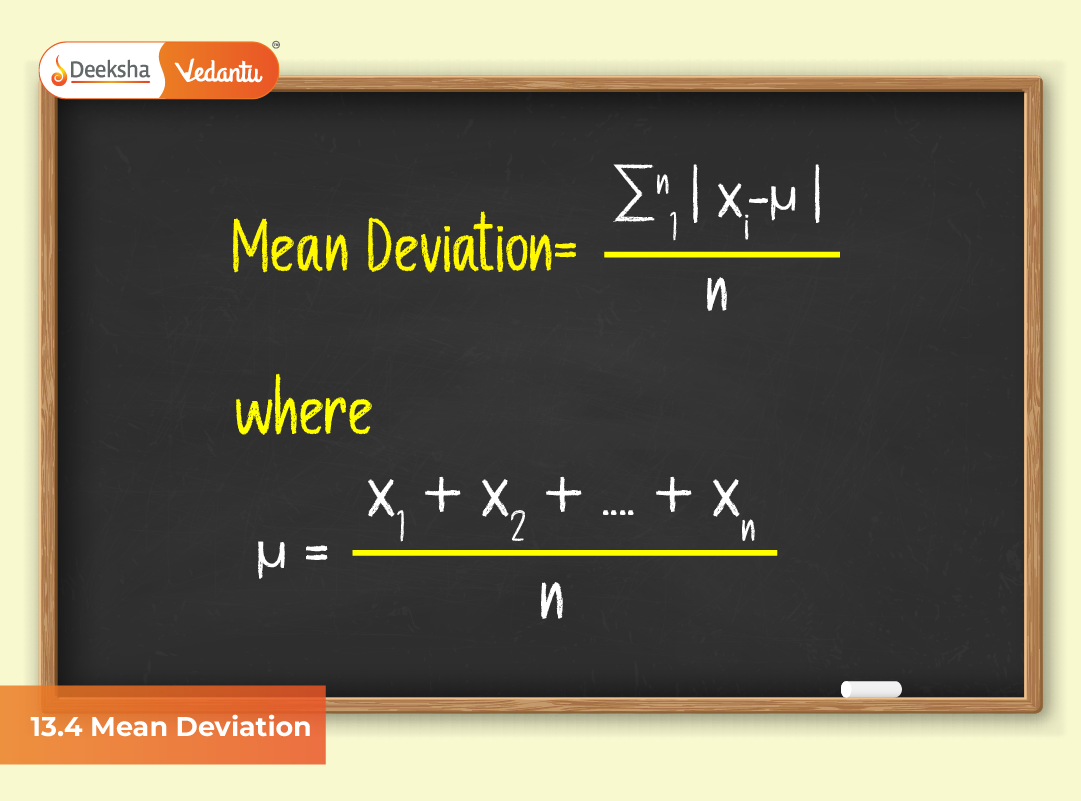
Introduction
Mean Deviation, often referred to as the average deviation, is a refined and systematic measure of dispersion. It tells us how far each data value deviates, on average, from a central value such as the mean or median. Unlike Range, which only considers the maximum and minimum values, Mean Deviation takes into account every data point. This makes it a more balanced and realistic measure of variation within a dataset.
For JEE aspirants, understanding Mean Deviation is crucial because it lays the groundwork for advanced concepts like Variance and Standard Deviation. It enhances your ability to interpret data, analyze patterns, and make sense of how spread out or consistent data values are — skills that are directly applicable in statistical, probability, and real-world physics or economics problems.
In essence, Mean Deviation provides a bridge between simple dispersion measures (like Range) and more complex measures (like Variance). It is particularly helpful when you need a straightforward but informative measure of variability.
Definition
The Mean Deviation (M.D.) of a dataset about a central value ‘a’ is defined as the arithmetic mean of the absolute deviations of each observation from that central value.
Mathematically,
M.D.(a) = Σ|x – a| / n
Here:
x = individual observations
a = central value (mean, median, or sometimes mode)
n = number of observations
We use absolute deviation (|x − a|) because if we simply summed the deviations (x − a), the positive and negative deviations would cancel each other out, giving a misleading zero. By taking absolute values, we measure true magnitude of deviation irrespective of direction.
Choice of Central Value
The choice of the central value ‘a’ depends on the type of dataset and the analysis purpose. In most cases, it is calculated about:
- Mean (x̄): When data is symmetrically distributed.
- Median (M): When data is skewed or contains outliers.
1. Mean Deviation about Mean (x̄)
M.D.(x̄) = Σ|x – x̄| / n
This represents the average of deviations from the mean and is ideal for symmetric data.
2. Mean Deviation about Median (M)
M.D.(M) = Σ|x – M| / n
This form is more appropriate for datasets with significant skewness or outliers since the median is less affected by extreme values.
Steps to Calculate Mean Deviation
To compute Mean Deviation, follow these systematic steps:
- Identify the central value (mean or median) for your data.
- Find deviations: Subtract this central value from each observation.
- Take absolute values of deviations (ignore positive/negative signs).
- Sum up all absolute deviations.
- Divide by the number of observations (n) to obtain the Mean Deviation.
This process applies both to raw data and to frequency distributions.
Example 1: Mean Deviation about Mean
The marks of five students are 5, 10, 15, 20, and 25.
Step 1: Mean (x̄)
x̄ = (5 + 10 + 15 + 20 + 25) / 5 = 15
Step 2: Calculate |x − x̄|
| x | |x − x̄| |
| 5 | 10 |
| 10 | 5 |
| 15 | 0 |
| 20 | 5 |
| 25 | 10 |
Step 3: Mean Deviation
M.D.(x̄) = (10 + 5 + 0 + 5 + 10) / 5 = 6
Hence, Mean Deviation = 6. This means, on average, each mark deviates 6 units from the mean.
Example 2: Mean Deviation about Median
The ages of seven workers are: 20, 22, 24, 26, 28, 30, 32.
Step 1: Median = 26 (middle value)
Step 2: |x − M|
| x | |x − M| |
| 20 | 6 |
| 22 | 4 |
| 24 | 2 |
| 26 | 0 |
| 28 | 2 |
| 30 | 4 |
| 32 | 6 |
Step 3: Mean Deviation
M.D.(M) = (6 + 4 + 2 + 0 + 2 + 4 + 6) / 7 = 3.43
Hence, Mean Deviation about the median ≈ 3.43 years.
Example 3: Frequency Distribution
| x | f |
| 10 | 3 |
| 20 | 5 |
| 30 | 7 |
| 40 | 5 |
| 50 | 4 |
Step 1: Mean (x̄)
x̄ = (10×3 + 20×5 + 30×7 + 40×5 + 50×4) / 24 = 32.5
Step 2: Calculate |x − x̄| and f|x − x̄|
| x | f | |x − x̄| | f|x − x̄| |
| 10 | 3 | 22.5 | ₹68 |
| 20 | 5 | 12.5 | ₹63 |
| 30 | 7 | 2.5 | ₹18 |
| 40 | 5 | 7.5 | ₹38 |
| 50 | 4 | 17.5 | ₹70 |
Sum of f|x − x̄| = 255
Step 3: Mean Deviation
M.D.(x̄) = 255 / 24 = 10.63
Thus, the Mean Deviation about the mean is approximately 10.63.
Importance of Mean Deviation
- Offers a clearer view of variation than Range.
- Less impacted by extreme values, providing stable results.
- Facilitates comparison between different datasets.
- Used widely in fields like economics, sociology, business analysis, and engineering.
- Helps identify consistency or irregularity within datasets.
Comparison of Mean Deviation and Range
| Aspect | Range | Mean Deviation |
| Definition | Difference between max and min | Average of absolute deviations |
| Considers | Only extreme values | All data points |
| Sensitivity | Highly sensitive to outliers | Less sensitive |
| Interpretation | Rough measure | More detailed measure |
| Computation | Simple | Moderate |
| Application | Quick estimate | Analytical insight |
Limitations of Mean Deviation
- Involves absolute values, making it unsuitable for certain algebraic manipulations.
- Requires more computation than simple Range.
- Does not provide squared deviations like Variance, so it’s less powerful in inferential statistics.
Real-Life Applications
- Economics: Measuring income inequality and economic disparity.
- Education: Evaluating the consistency of student performance.
- Business: Assessing production and sales variability.
- Science and Engineering: Analyzing experimental data precision and process reliability.
- Sports Analytics: Understanding consistency in athlete performance metrics.
JEE-Based Example 4 (Advanced)
The daily wages (₹) of 6 workers are 150, 200, 250, 300, 350, and 400. Find Mean Deviation about Mean.
x̄ = (150 + 200 + 250 + 300 + 350 + 400) / 6 = 275
| x | |x − x̄| |
| 150 | 125 |
| 200 | 75 |
| 250 | 25 |
| 300 | 25 |
| 350 | 75 |
| 400 | 125 |
M.D.(x̄) = 450 / 6 = 75
Thus, the Mean Deviation = 75. This shows the average daily wage deviation from the mean is ₹75.
FAQs
Q1. What is Mean Deviation in Statistics?
It is the average of the absolute deviations of each observation from the mean or median, representing the degree of uniformity or variation in a dataset.
Q2. What is the formula for Mean Deviation?
M.D.(a) = Σ|x – a| / n
Q3. Which central values are used to calculate Mean Deviation?
It is usually computed about the Mean (x̄) or the Median (M), depending on data symmetry and presence of outliers.
Q4. What does a smaller Mean Deviation signify?
A smaller Mean Deviation indicates higher consistency and less variability among data points.
Q5. How is Mean Deviation beneficial for JEE preparation?
Understanding Mean Deviation enhances analytical reasoning in data handling, helps in interpreting spread in statistical problems, and builds confidence for advanced topics like Standard Deviation and Probability.
Conclusion
Mean Deviation serves as a vital concept in understanding statistical dispersion. It provides a realistic measure of variation without overcomplicating calculations. Positioned between the simplicity of Range and the precision of Standard Deviation, it balances clarity with mathematical utility. For JEE aspirants, mastering Mean Deviation enhances conceptual understanding, improves analytical accuracy, and forms a strong foundation for advanced data analysis and probability-based problems.






Get Social